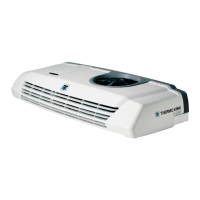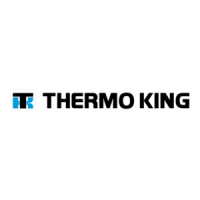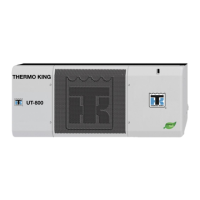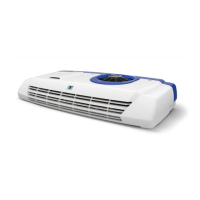Do you have a question about the Thermo King V250 and is the answer not in the manual?
Guidelines for safe operation and handling of the refrigeration unit.
Precautions for handling refrigerants and first aid for exposure.
Guidelines for handling refrigeration oil and first aid for contact.
Safety measures for high and low voltage circuits during servicing.
Overall technical details including compressor and oil specifications.
Specific parameters for the R-134a system, including charge and switches.
Specific parameters for the R-404a system, including charge and switches.
Details on fuses, fan motors, and solenoid coil specifications.
Recommended belt tensions for engine and electric motor drive.
Initial checks after the first week of unit operation.
Description of the unit's three main assemblies and mounting options.
Explanation of how the liquid injection system cools the compressor.
Description of the oil separator's role in compressor lubrication.
How the unit operates using the truck engine.
How the unit operates using electric standby power.
Thermostat control for cooling operations.
Thermostat control for the null (standby) operating mode.
Thermostat control for heating operations.
Explanation of automatic and manual defrost initiation and termination.
Diagram illustrating thermostat mode shift logic.
List of key features, protection devices, and optional features.
Information on where to find serial numbers for unit components.
Description of the cab control box keys, indicators, and display.
Description of components within the low voltage box.
Description of components within the high voltage box for Model 20.
Explanation of fuses, circuit breakers, and cutout switches.
Instructions for pre-trip checks, starting, and basic operation.
Procedure for setting and checking the thermostat setpoint.
Checks to perform after starting the unit.
Steps for loading product into the refrigerated compartment.
Steps to take after product loading is complete.
Routine inspections to be performed after trips.
Checking wiring harnesses for damage to prevent malfunctions.
Adjusting temperature scale and setpoint range via dip switches.
Procedure to adjust the thermostat setpoint differential.
Procedures for testing thermometer and thermostat functions.
Procedure to test the resistance and function of the temperature sensor.
Troubleshooting steps for a malfunctioning cab control box.
Procedure to verify thermometer accuracy.
Testing thermostat operation across different temperature modes.
Testing thermostat function during engine operation.
Testing thermostat function during electric standby operation.
Overview of defrost system operation for engine and standby modes.
Description of defrost timer, manual defrost key, and termination switch.
Troubleshooting the defrost system and identifying P.C. boards.
Information on identifying different versions of P.C. boards.
Specific troubleshooting steps for the first version P.C. board.
Troubleshooting steps for second and third version P.C. boards.
Procedure to test the M10 (V250/V-090) cab control box.
Description and testing procedure for the CFPS.
Checks for contactors, overload relay, and standby circuits.
Troubleshooting the 12-volt system components.
Procedure to test evaporator heater resistance.
Detailed steps for charging and evacuating the refrigeration system.
Procedure for adding liquid refrigerant to the system.
Method to test refrigerant charge with an empty box.
Method to test refrigerant charge with a loaded box.
Procedure to ensure adequate compressor oil supply.
Location and function of the HPCO switch.
Location and function of the LPCO switch.
Steps for cleaning the refrigeration system after contamination.
Procedure for returning the unit to service after cleanup.
Steps for compressor removal and installation.
Procedures for servicing condenser components.
Steps for drier removal and installation.
Procedures for receiver tank removal and installation.
Procedures for high pressure and condenser fan pressure switches.
Procedures for hot gas solenoid valve removal and installation.
Procedures for liquid injection solenoid valve removal and installation.
Steps for oil separator removal and installation.
Procedures for metering orifice removal and installation.
Testing and repair procedures for the Model 20 check valve.
Detailed steps for replacing a check valve.
Procedures for evaporator coil removal and installation.
Procedures for expansion valve assembly removal and installation.
Procedures for low pressure cutout switch removal and installation.
Procedures for suction pressure regulator valve removal and installation.
Steps for disassembling and assembling refrigerant hoses.
Explanation of how the compressor clutch operates.
Step-by-step procedure for removing the compressor clutch.
Inspection points for drive plate, pulley assembly, and coil.
Procedure for installing the compressor clutch components.
Procedures for removing and installing shaft seal cover and seal.
Detailed steps for correctly installing the shaft seal.
List and images of special tools required for clutch service.
Information on compressor installation, oil, and system contamination.
Procedure for draining and checking compressor oil level.
Identifying and addressing oil contamination in the system.
Connecting the clutch electrically and performing engagement tests.
Guidelines for checking and adjusting belt tensions.
Identifying causes of excessive heat load on the system.
Impact of dirt on evaporator and condenser coils.
Effects of improper belt tension on unit performance.
Symptoms and actions for a refrigerant shortage.
Identifying issues related to expansion valve settings.
Impact of excessive oil on system performance.
Symptoms and checks for moisture in the system.
Factors that shorten compressor lifespan.
Technical specifications and dimensions for road compressors.
Formula for calculating compressor RPM and relative performance chart.
Guidelines for safe operation and handling of the refrigeration unit.
Precautions for handling refrigerants and first aid for exposure.
Guidelines for handling refrigeration oil and first aid for contact.
Safety measures for high and low voltage circuits during servicing.
Overall technical details including compressor and oil specifications.
Specific parameters for the R-134a system, including charge and switches.
Specific parameters for the R-404a system, including charge and switches.
Details on fuses, fan motors, and solenoid coil specifications.
Recommended belt tensions for engine and electric motor drive.
Initial checks after the first week of unit operation.
Description of the unit's three main assemblies and mounting options.
Explanation of how the liquid injection system cools the compressor.
Description of the oil separator's role in compressor lubrication.
How the unit operates using the truck engine.
How the unit operates using electric standby power.
Thermostat control for cooling operations.
Thermostat control for the null (standby) operating mode.
Thermostat control for heating operations.
Explanation of automatic and manual defrost initiation and termination.
Diagram illustrating thermostat mode shift logic.
List of key features, protection devices, and optional features.
Information on where to find serial numbers for unit components.
Description of the cab control box keys, indicators, and display.
Description of components within the low voltage box.
Description of components within the high voltage box for Model 20.
Explanation of fuses, circuit breakers, and cutout switches.
Instructions for pre-trip checks, starting, and basic operation.
Procedure for setting and checking the thermostat setpoint.
Checks to perform after starting the unit.
Steps for loading product into the refrigerated compartment.
Steps to take after product loading is complete.
Routine inspections to be performed after trips.
Checking wiring harnesses for damage to prevent malfunctions.
Adjusting temperature scale and setpoint range via dip switches.
Procedure to adjust the thermostat setpoint differential.
Procedures for testing thermometer and thermostat functions.
Procedure to test the resistance and function of the temperature sensor.
Troubleshooting steps for a malfunctioning cab control box.
Procedure to verify thermometer accuracy.
Testing thermostat operation across different temperature modes.
Testing thermostat function during engine operation.
Testing thermostat function during electric standby operation.
Overview of defrost system operation for engine and standby modes.
Description of defrost timer, manual defrost key, and termination switch.
Troubleshooting the defrost system and identifying P.C. boards.
Information on identifying different versions of P.C. boards.
Specific troubleshooting steps for the first version P.C. board.
Troubleshooting steps for second and third version P.C. boards.
Procedure to test the M10 (V250/V-090) cab control box.
Description and testing procedure for the CFPS.
Checks for contactors, overload relay, and standby circuits.
Troubleshooting the 12-volt system components.
Procedure to test evaporator heater resistance.
Detailed steps for charging and evacuating the refrigeration system.
Procedure for adding liquid refrigerant to the system.
Method to test refrigerant charge with an empty box.
Method to test refrigerant charge with a loaded box.
Procedure to ensure adequate compressor oil supply.
Location and function of the HPCO switch.
Location and function of the LPCO switch.
Steps for cleaning the refrigeration system after contamination.
Procedure for returning the unit to service after cleanup.
Steps for compressor removal and installation.
Procedures for servicing condenser components.
Steps for drier removal and installation.
Procedures for receiver tank removal and installation.
Procedures for high pressure and condenser fan pressure switches.
Procedures for hot gas solenoid valve removal and installation.
Procedures for liquid injection solenoid valve removal and installation.
Steps for oil separator removal and installation.
Procedures for metering orifice removal and installation.
Testing and repair procedures for the Model 20 check valve.
Detailed steps for replacing a check valve.
Procedures for evaporator coil removal and installation.
Procedures for expansion valve assembly removal and installation.
Procedures for low pressure cutout switch removal and installation.
Procedures for suction pressure regulator valve removal and installation.
Steps for disassembling and assembling refrigerant hoses.
Explanation of how the compressor clutch operates.
Step-by-step procedure for removing the compressor clutch.
Inspection points for drive plate, pulley assembly, and coil.
Procedure for installing the compressor clutch components.
Procedures for removing and installing shaft seal cover and seal.
Detailed steps for correctly installing the shaft seal.
List and images of special tools required for clutch service.
Information on compressor installation, oil, and system contamination.
Procedure for draining and checking compressor oil level.
Identifying and addressing oil contamination in the system.
Connecting the clutch electrically and performing engagement tests.
Guidelines for checking and adjusting belt tensions.
Identifying causes of excessive heat load on the system.
Impact of dirt on evaporator and condenser coils.
Effects of improper belt tension on unit performance.
Symptoms and actions for a refrigerant shortage.
Identifying issues related to expansion valve settings.
Impact of excessive oil on system performance.
Symptoms and checks for moisture in the system.
Factors that shorten compressor lifespan.
Technical specifications and dimensions for road compressors.
Formula for calculating compressor RPM and relative performance chart.
| Brand | Thermo King |
|---|---|
| Model | V250 |
| Category | Refrigerator |
| Language | English |











